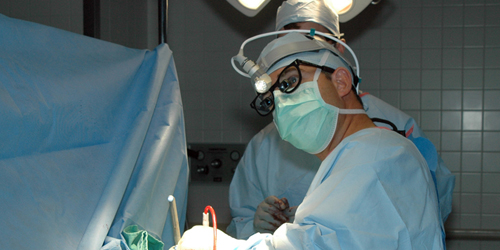
By Christopher McPherson, MD
It sounds like something out of a Hollywood movie: having brain surgery while you’re awake! In fact, it is painless. More importantly, it can save your life.
This type of operation is called an awake craniotomy. It begins with careful planning, the blending of multiple types of brain scans, and the creation of computerized mapping that will help us safely navigate around the brain’s eloquent regions. The neurosurgeon then cuts a hole in the skull so that we can reach the problem area, which could be a tumor, the place where a seizure begins, or another type of lesion.
Contrary to popular opinion, an awake craniotomy is not performed very often. I do about 5 of these cases a year, and I have done 50 to 60 during my career. We primarily perform an awake craniotomy when we are resecting (removing) a tumor near functional areas of the brain that are related to speech.
Operating with the patient awake and talking to us offers a significant advantage: it allows us to accurately test a patient’s speech and to localize the areas that enable the patient to speak and write. With this knowledge, we can remove the tumor while maintaining speech function. In addition, by tracking the boundaries of the patient’s speech region, we know when to stop removing tissue. Thus, we can balance maximal resection of the tumor with maintenance of function.
I know it sounds scary, but patients actually do very well with this procedure. We spend a lot of time explaining and preparing the patient before surgery so that they understand what is going to happen. As a patient of my Mayfield colleague, Vincent DiNapoli, MD, PhD, recently told reporter Kristyn Hartman of WCPO, “There was really never a time when I thought, ‘We need to stop!’ and I started freaking out. It was really very smooth.”
There is also something to be said for patient selection. Some very anxious patients – and they are rare exceptions – will not be able to do this. During my career I have had only one patient who could not tolerate the procedure because of excessive anxiety.
We can accomplish an awake craniotomy because the patient feels no pain. This might come as a surprise. We have all had nasty headaches, right? And a bump on the head surely hurts. But the soft, custard-like brain itself has no pain receptors. To begin the procedure we numb the skin of the scalp very well and let the patient relax in a light twilight sleep as we make the incision and create an opening in the dura mater, the thick outer membrane that covers the brain.
We then awaken the patient for the actual brain surgery portion, which the patient does not feel. We talk to the patient throughout the surgery about anything you would ordinarily discuss at the dinner table, from family activities to sports to favorite TV shows. With our patient helping us navigate the brain, we are well equipped to achieve our own version of a Hollywood ending.
* * * * *
Christopher McPherson, MD, is a neurosurgeon with Mayfield Brain & Spine and Site Director of Neurosurgery at Good Samaritan Hospital.